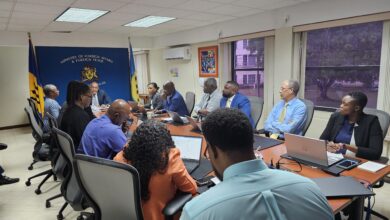By HE David A Granger MSS
The world is likely to face a food crisis by 2050 unless agricultural production increases. The Food and Agricultural Organization estimates that there will be an additional two billion mouths to feed in the world within the next thirty-five years. The growth of the world’s population along with increased urbanization is expected to increase the demand for agricultural produce by some 70 per cent by 2050.
The ability of many countries to meet this demand will be affected by climate change. The global phenomenon of climate change is resulting in increased desertification and the depletion of freshwater supplies.
Guyana’s abundance of land and freshwater supplies for agricultural purposes places it in an enviable position to take advantage of the increased demand for food globally.
Opportunities for increased agricultural markets exist within the Caribbean Community (CARICOM). The Region’s agriculture’s sector share of Gross Development Product (GDP) declined from 13 percent to 7 percent, over the last 25 years.
International food prices have been declining for the major traded agricultural products and are at the lowest levels since 2009. The food import bill of CARICOM has been rising and stands, today, at over US$4 Billion annually.
CARICOM’s food insecurity must be reversed if the Caribbean is to survive. Guyana’s farmers can contribute to regional food security by increasing agricultural output. Caribbean leaders are looking to Guyana as the new horizon for agricultural development.
Guyana can play a meaningful role in becoming the rice bowl and vegetable basket of the Caribbean. Guyana can play such a role through investment, infrastructure, information and innovation in agriculture.
· Investment: I visited a mega farm located at Meritizero in the Rupununi region. The farm is owned by an investor from Barbados. It is one of this country’s largest farms, consisting of almost 12,500 hectares.
The farm has defied the long held belief that our savannahs are only suitable for rearing cattle. The Farm is a thriving agricultural enterprise producing boulangers, corn, fruit, lettuce, ground provisions and rice. The farm is exporting rice to Brazil.
The farm is a model for regional investment in agriculture. I have invited regional leaders to invest in Guyana, including investing in Guyana’s vast agricultural potential.
The countries of the Caribbean have the capital. We have the land and freshwater. There is no reason why we should not engage in a partnership aimed at increasing agricultural output to help achieve food security in the Caribbean
· Infrastructure: Infrastructure is a key factor in agricultural development. The farmers in several communities know this all too well. The deplorable conditions of the roads and dams:
– Increased the cost for farmers to access inputs into their production;
– increased the cost of transporting produce to markets; and
– increased the levels of spoilage and losses.
Infrastructure, such as the roads, will facilitate greater access, by our farmers to inputs. It will allow them, also, to get their production more easily and quickly to the markets.
The roads are a means to stimulate the rural non-farm economy, catalyze the development of communities, and facilitate the integration of rural areas into national economies.
Infrastructural development has both direct and indirect effects on output and productivity. I have been informed that in Ruby Back (Essequibo Islands-West Demerara), there has been a 25 per cent increase in acreage of cash crops under cultivation from 2014 to present, whilst in Naamryck-Parika Back, there has been a 50 per cent increase in acreage under cash crop cultivated from 2014. We will continue to invest in agricultural infrastructure.
· Information: Farmers in some regions have long suffered from poor prices for their produce. Farmers must not be satisfied with solely producing for the local markets. The expansion of their production depends on finding new markets, including export markets.
Farmers need information to be able to penetrate into these markets. Farmers must seek information and use information to reduce their exploitation by middle men who rake in the bulk of the proceeds from the sale of agricultural produce. Information will allow farmers to know about the export markets that are available, the quality which those markets demand, the prices on offer and the procedures to be followed.
Food security involves encouraging farmers to produce more. We will do this by ensuring that farmers gain more for their production. Increased incomes mean that more resources are available to plough into expanding production. We will establish farmers’ markets which would allow farmers to retail their produce at prices higher than they would obtain from the middle men.
· Innovation: Guyana’s agricultural sector must become more resilient. It must reduce its exposure to commodity price downturns. The agricultural sector must lead the revival of rural Guyana by ensuring that production moves up the value chain through increased agro-processing.
The processing of agricultural produce will also help farmers to reduce the present high levels of spoilage. Farmers must not be discouraged by the past experiences at moving up the value chain.
-The Hubu cassava mill was expected to allow farmers to receive a higher price for their produce. The higher price did not materialize. The farmers felt betrayed and withheld their produce from the mill. A private company later bought the mill from the government and used it to produce snack foods.
– The Parika Packaging Facility was established to help farmers to get higher value for their production through exports. The project has not developed as expected. We intend to look to private enterprise to promote greater agro- processing and packaging.
News
Guyana’s farmers can contribute to regional food security – President David Granger






